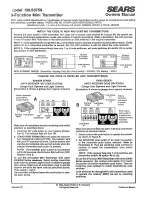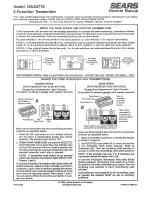
Section 1
1.1
INSTALLATION
The overall accuracy of a density measurement depends on several variables. Although the
transmitter has an outstanding performance, proper installation is essential to maximize its
performance.
Among all factors, which may affect transmitter accuracy, environmental conditions are the most
difficult to control. There are, however, ways of reducing the effects of temperature, humidity and
vibration.
General
The
DT302
has a built-in temperature sensor to compensate for temperature variations. At the
factory, each transmitter is submitted to a temperature cycle process, and the characteristics under
different pressures and temperatures are recorded in the transmitter memory. At the field, this
feature minimizes the temperature variation effect.
Locating the transmitter in areas protected from extreme environmental changes can minimize
temperature fluctuation effects.
The transmitter should be installed in such a way as to avoid, as much as possible, direct exposure
to the sun or any source of irradiated heat.
Humidity is fatal for electronic circuits. In areas subjected to high relative humidity, the O-rings for
the electronic housing covers must be correctly placed and the covers must be completely closed by
tightening them by hand until the O-rings are compressed.
Do not use tools to close the covers. Removal of the electronics cover in the field should be reduced
to the minimum necessary, as each time it is removed; the circuits are exposed to the humidity. The
electronic circuit is protected by a humidity proof coating, but frequent exposure to humidity may
affect the protection provided. It is also important to keep the covers tightened in place. Every time
they are removed, the threads are exposed to corrosion, since painting cannot protect these parts.
Although the transmitter is virtually insensitive to vibration, installation close to pumps, turbines or
other vibrating equipment should be avoided.
Recommendation in using of DT302
The process fluid must always cover the two repeater diaphragms.
The maximum process fluid velocity over the two repeater diaphragms must be 0.4m/sec, what
means a flow of 26 m
3
/h in a piping of
6”. This information is according to fluids which viscosity is
close to that water. For fluids where the viscosity is very different to that water viscosity should be
analyzed. This limitation is due to the losing of load between the diaphragms.
For applications in corrosive fluids, compatible material with the process fluid must be chosen.
Materials that are not in contact with the process, but can be in contact with the corrosive
atmosphere or process residues also must be considered.
Verify if a possible leak of fill fluid (unless than 5ml), due an orifice in the diaphragm can
contaminate the process. If it is not permitted, please, chose a compatible fill fluid.
Verify if the fill fluid does not evaporate in the conditions of limit temperatures and limit pressures of
the process.
Summary of Contents for DT302
Page 7: ...Kpuvcnncvkqp Hnqyejctv XKK Kpuvcnncvkqp Hnqyejctv...
Page 8: ...FV524 Qrgtcvkqp Ockpvgpcpeg cpf Kpuvtwevkqpu Ocpwcn XKKK...
Page 34: ...DT302 Operation Maintenance and Instructions Manual 2 4...
Page 65: ...Maintenance Procedures 4 7 Figure 4 4 DT302 Exploded View Industrial Model...
Page 68: ...DT302 Operation Maintenance and Instructions Manual 4 10...
Page 79: ...Egtvkhkecvkqpu Kphqtocvkqp C07 EXAM and NEMKO...
Page 80: ...FV524 Qrgtcvkqp Ockpvgpcpeg cpf Kpuvtwevkqpu Ocpwcn C08 CEPEL...
Page 81: ...Egtvkhkecvkqpu Kphqtocvkqp C09 Control Drawing Factory Mutual FM...
Page 82: ...FV524 Qrgtcvkqp Ockpvgpcpeg cpf Kpuvtwevkqpu Ocpwcn C0...
Page 84: ...DT302 Operation Maintenance and Instructions Manual B 2...










































